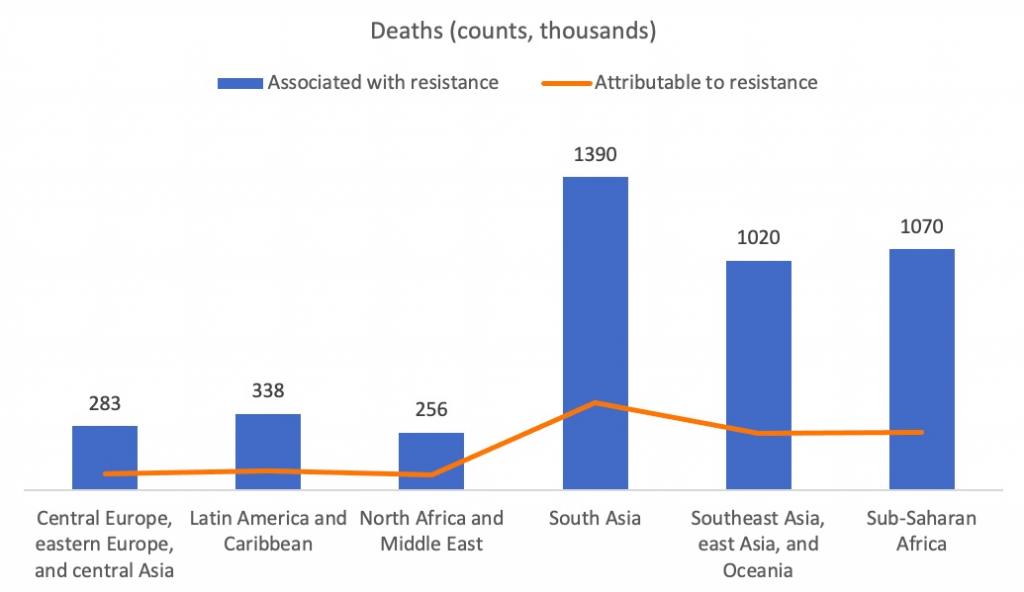

A recent study in The Lancet showed alarming casualties due to antimicrobial resistance globally, especially Asia and Africa; it also demonstrated the global need to act



Antimicrobial resistance (AMR) is a ticking time bomb, both, for the world and for India. The latest to vindicate this fact is a study published in The Lancet that has thrown up alarming figures about casualties due to AMR.
The study calculated the disease burden on the basis of two criteria:
The analysis estimated that there were 4.95 million deaths associated with bacterial AMR in 2019, including 1.27 million deaths attributable to bacterial AMR.
The study also showed global disparity while drawing global attention to the AMR threat in Asia and Africa.
Deaths (counts, thousands) associated with and attributable to bacterial antimicrobial resistance, globally and by GBD super-region, 2019

*Source: Lancet study
The deaths per thousand associated with AMR for central Europe, eastern Europe and central Asia (283), Latin America and the Caribbean (338), North Africa and the Middle East (256) combined, was found to be less than south Asia (1,390) or southeast Asia, east Asia and Oceania (1,020) or sub-Saharan Africa (1,070) regions.
In 2019, Australasia had the lowest and western sub-Saharan Africa had the highest AMR burden (6.5 and 27.3 deaths per 100,000 attributable to AMR; 28 and 114.8 deaths per 100,000 associated with AMR, respectively).
Read: Ineffective magic bullets: Antibiotic resistance is now the leading cause of deaths across the globe
A similar trend is seen for deaths attributable to AMR. Disability adjusted life years (DALYs) were high in south Asia (59,900), southeast Asia, east Asia and Oceania (27,900) and sub-Saharan Africa (66,200).
The number of deaths and DALYs attributable to and associated with bacterial AMR in 2019 were estimated for 23 pathogens and 88 pathogen-drug combinations in 204 countries and territories.
The authors of the study also acquired data for 471 million individual records or isolates and 7,585 study-location-years from a range of sources.
The analysis presented data around six major pathogens. These were:
More than 70 per cent deaths attributable to AMR were across pathogens for first-line therapy for severe infections, such as fluoroquinolones and β-lactam antibiotics.
Deaths due to different causes, 2019

*Source: Lancet study and IHME GBD tool
Pathogen-drug combinations have also been a major reason for deaths, underlining the significance of adopting policies that specifically target the deadliest pathogen-drug combinations.
Global deaths (counts) attributable to bacterial AMR by pathogen-drug combination shows highest trends for third-generation cephalosporins, carbapenems, fluoroquinolones, meticillin and trimethoprim-sulfamethoxazole.
Raw data and modelled estimates for the percentage of pathogen isolates that are resistant by country and territory in 2019 showed that India had one of highest burdens of AMR. India stood out among most countries in Asia and exhibited maximal resistance trends in the region.
The Lancet piece also highlighted there were significant data gaps in many low-income settings.
This highlighted the need to expand microbiology laboratory capacity and data collection systems in these settings, that will aid in better understanding of AMR, which has the highest burden in such settings.
Read more on DTE's coverage on Antimicrobial resistance here
We are a voice to you; you have been a support to us. Together we build journalism that is independent, credible and fearless. You can further help us by making a donation. This will mean a lot for our ability to bring you news, perspectives and analysis from the ground so that we can make change together.

Comments are moderated and will be published only after the site moderator’s approval. Please use a genuine email ID and provide your name. Selected comments may also be used in the ‘Letters’ section of the Down To Earth print edition.